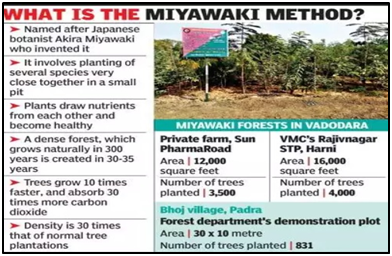Miyawaki forests
Why in news?
- PM Modi during his latest ‘Mann ki baat’ episode spoke about Miyawaki plantation, the Japanese method of creating dense urban forests in a small area.
- The PM also cited the example of a Kerala-based teacher, Raafi Ramnath, who used the Miyawaki technique to transform a barren land into a mini forest called Vidyavanam by planting 115 varieties of trees.
- The Brihanmumbai Municipal Corporation (BMC) has also been creating Miyawaki forests in several open land parcels of Mumbai.
What’s in today’s article?
- Miyawaki forests
Miyawaki forests
- Miyawaki forests or Miyawaki technique, refer to a unique approach to afforestation and ecological restoration developed by Japanese botanist Akira Miyawaki.
- The methodology was developed in the 1970s, with the basic objective to densify green cover within a small parcel of land.
- The method involves creating dense, multi-layered forests that grow rapidly and mimic the natural biodiversity of native forests.
- This method involves planting two to four different types of indigenous trees within every square metre.
- The plants used in the Miyawaki method are mostly self-sustaining and don’t require regular maintenance like manuring and watering.
- In this method, the trees become self-sustaining and they grow to their full length within three years.
Key principles of the Miyawaki Method
- Biodiversity:
- Planting numerous native species in close proximity to encourage natural competition, symbiotic relationships, and the development of a self-sustaining ecosystem.
- Dense planting:
- High-density planting of trees ensures that the canopy closes quickly, minimizing sunlight reaching the ground.
- It reduces the weed growth, thus enhancing the growth of tree saplings.
- High-density planting of trees ensures that the canopy closes quickly, minimizing sunlight reaching the ground.
- Soil preparation:
- The soil is carefully prepared by adding organic matter, nutrients, and microorganisms to create a fertile and conducive environment for tree growth.
- Mulching:
- Mulch is applied to the forest floor to retain moisture, suppress weed growth, and enhance soil fertility.
- Regular maintenance:
- Proper care and maintenance, such as watering, weeding, and monitoring, are crucial during the initial years to ensure the successful establishment of the forest.
Benefits
- Rapid forest development:
- Miyawaki forests have a remarkable growth rate, with trees reaching maturity in a much shorter time compared to traditional plantations.
- A study revealed that Miyawaki forests grow 10x faster, are 30 x denser and contain 100x more biodiversity.
- High biodiversity:
- These forests become thriving habitats for birds, insects, and other wildlife, contributing to overall ecosystem health and resilience.
- Enhanced carbon sequestration:
- The dense vegetation and rapid growth of these forests enable efficient carbon absorption, helping to mitigate climate change and reduce greenhouse gas emissions.
- Improved soil quality:
- The careful soil preparation results in the enrichment of soil fertility and structure.
- Noise and air pollution reduction:
- Miyawaki forests planted in urban areas can help mitigate noise pollution by acting as sound barriers and absorbing sound waves.
- Additionally, they contribute to improving air quality by absorbing pollutants and particulate matter, thereby reducing air pollution levels.
- Sustainable water management:
- The dense vegetation of Miyawaki forests act as natural sponges, absorbing rainfall and reducing runoff, thus contributing to better water retention and preventing water pollution.
- Regulates surface temperature
- Miyawaki forests can help regulate surface temperatures, particularly in urban areas where the urban heat island effect is a concern.
- The urban heat island effect refers to the phenomenon where urban areas experience higher temperatures compared to surrounding rural areas.
- This is due to human activities, the presence of buildings and pavement, and the lack of vegetation
- Miyawaki forests can help regulate surface temperatures, particularly in urban areas where the urban heat island effect is a concern.
